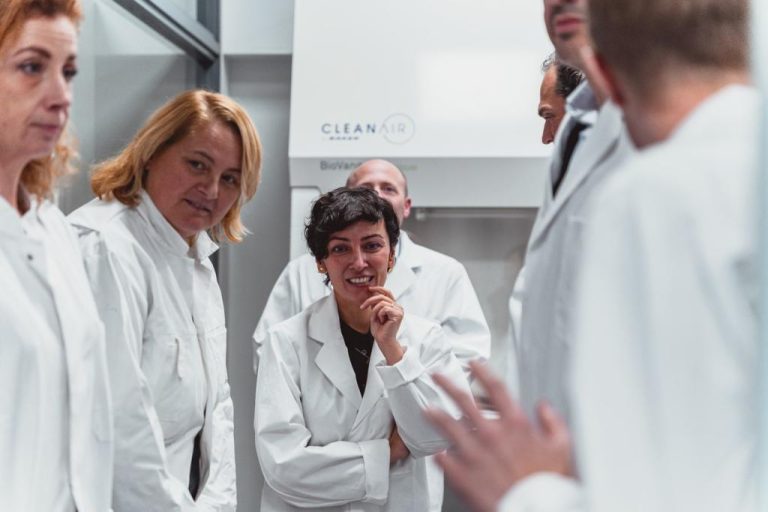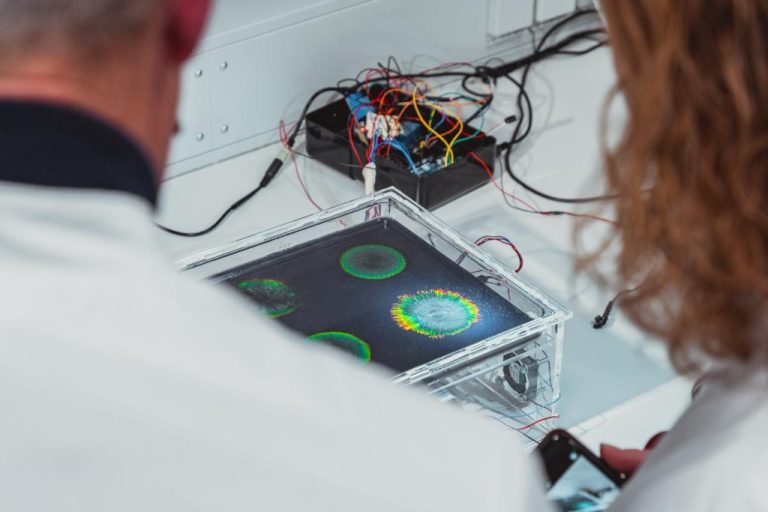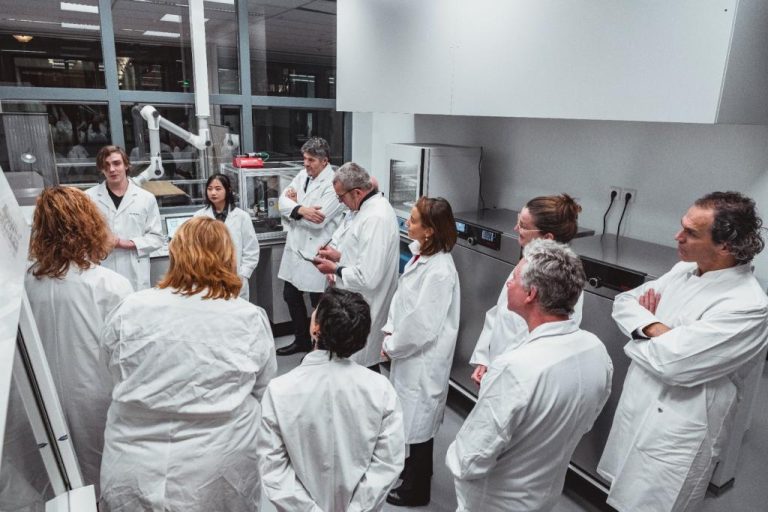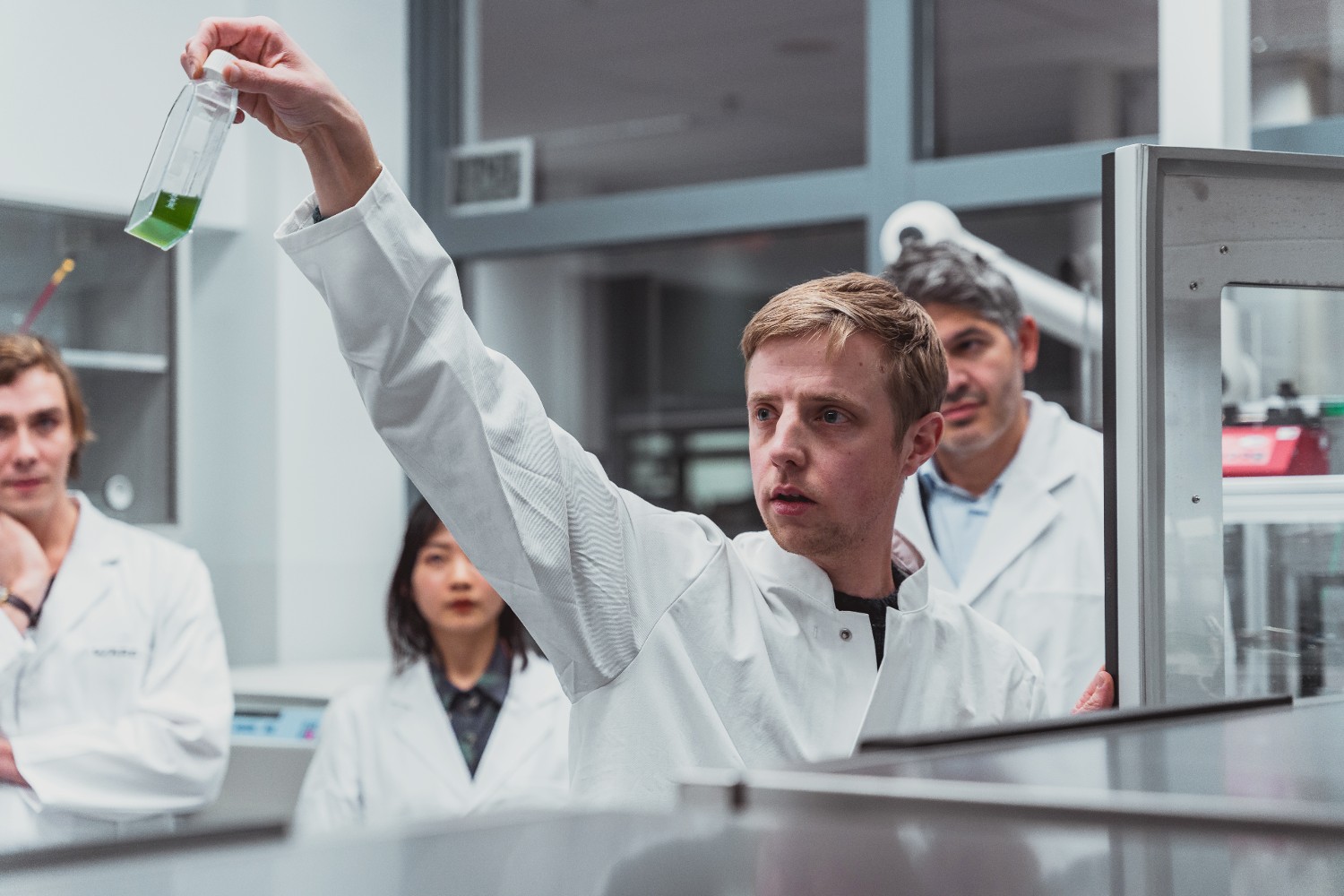Air-purifying curtains, living sensors and healing facial masks. These and more are what the Biodesign Lab envisions. The opening of the Lab took place last week.
Joren Wierenga shows a culture of Cyanobacteria at the opening of the IDE Biodesign Lab (Photo: Patrick Wetzels | TU Delft)
“Who has medium?” Dr Joren Wierenga, Research Technician, asks as he hands out lab coats to visitors on the opening night of the Biodesign Lab (Thursday, 15 December 2022). This lab is the only place in the Industrial Design Engineering (IDE) building where lab coats are mandatory. It is an ML-1 lab, where work on microorganisms with small health or environmental risks can be done.
Visitors enter it through a lock. There, two PhD students are waiting to present their research. Once inside, the visitors are surrounded by microbiological lab inventory: an autoclave for sterilisation, a freezer, a fume cupboard, culture cabinets (incubators), a centrifuge, and microscopes.
PhD student Ward Groutars shows a Plexiglas setup in which round colourful patterns grow above a black background. These are colonies of Flavobacteria, Groutars explains. The colours are caused by microstructures that the bacteria form, just like the grooves of a CD or a thin oil slick on water. Groutars is exploring living sensors. Flavobacteria respond to temperature, moisture, and to other organisms. They express their well-being with colours. It might be possible to use this property as an environmental sensor.
His colleague Jiwei Zhou prints small circles of Cyanobacteria on paper. The blue-green bacteria are not algae, but they do photosynthesise, capturing CO2 and producing oxygen. Cyanobacteria also change colour in response to their environment. In the process, they also purify the air. Zhou mentions air-purifying bedroom curtains with green polka dots as a possible application.


Living materials for designers
“Biotechnology is the new starting point for the 21st century,” explains lead researcher Professor Elvin Karana (Faculty of Industrial Design and Engineering) at the ceremonial opening of ‘her’ new lab. It is 50 years since American researchers first successfully inserted an artificial DNA molecule into a bacterium. Ten years back, the book Bio Design on the overlap of nature, science and creativity was published. And now the Faculty of Industrial Design Engineering has its own Biodesign Lab that brings living materials within the realm of designers for the first time.
Materials and their properties have fascinated Karana since her PhD research (completed in 2009). She wrote: ‘Materials convey meanings: they look modern or traditional, they express luxury, they are associated with factories, or they evoke one’s childhood. How do materials acquire these meanings?’
In 2015, Karana set up the Materials Experience Lab with Professor Valentina Rognoli (Politechnico di Milano) with the aim of linking the technical properties and user experience of materials. The new Biodesign Lab now adds living materials to the inventory, from rock-hard multilayer composites to feathery fungal structures.


Growing colonies of Flavobacteria cause spectacular refraction of light. (Photo: Patrick Wetzels | TU Delft)
Research directions
The field of biodesign, making new things with living materials, is young and sprouting in many directions. One example is the Massachusetts Institute of Technology’s Livings Bits scheme, which views micro-organisms as bio-computers. They convert an input (temperature, antibodies or light) into a measurable output (colour, smell, motility).
At TU Delft, two research directions for the coming years are part of NextSkins, a European Pathfinder programme. The Biodesign Lab is collaborating with project coordinator Dr Marie-Eve Aubin-Tam (Faculty of Applied Sciences) and researchers from two other universities.
Aubin-Tam researches synthetic biological materials such as artificial mother-of-pearl and self-healing materials. She plans to scale up their production from centimetres to metres over the next few years
Karana is developing therapeutic biomaterials with Professor Tom Ellis (Imperial College London). Think of a facial mask made of bacterial cellulose that inhibits skin inflammation thanks to reactive yeast cells. She is aware that a living material requires a different approach than a standard cosmetic. Besides the question of acceptance of a ‘living’ mask, its quality may also deteriorate.
“The design world needs new and innovative materials,” Karana said at the opening, “with new ways of interaction and cleaner production models.” At the Biodesign Lab, from today, tomorrow’s designers can learn about such new and innovative materials: bacteria, algae and fungi.
<further info below video>
The beauty of Flaviobacteria.
Want to know more?
- History of genetic modification (Wikipedia)
- William Meyers, Bio design: nature, science, creativity, free download
- Website Materials Experience Lab
- TU Delft webpage on the EUropean NextSkins programme
- Website Living Bits by MIT Media Lab
- TU Delft stories: Alive and Kicking – designing with living materials
- Elvin Karana, Still Alive – Material Quality in Design, read on issuu
- Eduard Groutars, Clarice Risseeuw, Elvin Karana: Living Aesthetics of Flavobacteria (scientific article)
- Elvin Karana et al., Living Artefacts (scientific article, download as pdf)
- Biodesign master class


In the new IDE Biodesign Lab white labcoats are mandatory (Photo: Patrick Wetzels | TU Delft)
Do you have a question or comment about this article?
j.w.wassink@tudelft.nl


Comments are closed.